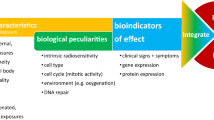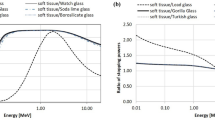Abstract
The risk of a radiation episode has increased in the last years due to several reasons. In case of a nuclear incident, as with the use of an improvised nuclear device, determination of the radiation doses received by the victims is of utmost importance to define the appropriate medical treatment or to monitor the late effects of radiation. Dose assessment in case of accidents can be performed using commonplace materials found in the accident area. In this paper, the dosimetric properties of monosodium glutamate are investigated by electron spin resonance spectroscopy (ESR), for retrospective and accidental dosimetry. The spectroscopic parameters were optimized to achieve higher signal intensity and better signal-to-noise ratio. As a result, the lowest detectable dose was 0.1 Gy, and monosodium glutamate showed a linear dose–response curve for doses ranging from 0.1 Gy to 10 kGy. The dosimetric signal was monitored from minutes right after irradiation, until 1 year. No changes in the signal intensity were observed over this period, meaning that doses could be assessed immediately after radiation exposure and can still be reconstructed long after the accident. This property also implies that late effects due to victim’s radiation exposure could be better monitored and understood. ESR signal intensity for samples irradiated with a photon energy below 100 keV was decreased by only 27% and no dose-rate dependence was noticed. Therefore, the ability to measure doses as low as 0.1 Gy, the high stability of the dosimetric signal, as well as independence on dose rate, tissue equivalence, low-cost, and wide commercial availability make monosodium glutamate a very good dosimetric material not only for retrospective and accidental but also for medical dosimetry.








Similar content being viewed by others
References
Ademola JA, Woda C (2017) Thermoluminescence of electronic components from mobile phones for determination of accident doses. Radiat Meas 104:13–21
Baffa O, Kinoshita A (2014) Clinical applications of alanine/electron spin resonance dosimetry. Radiat Environ Biophys 53:233–240
Bartolotta A, Fattibene P, Onori S, Pantaloni M, Petetti E (1993) Sources of uncertainty in therapy level alanine dosimetry. Appl Radiat Isot 44:13–17
Brai M, Gennaro G, Marrale M, Bartolotta A, D’Oca MC (2007) ESR response to gamma-rays of alanine pellets containing B(OH)3 or Gd2O3. Appl Radiat Isot 65:435–439
Breen SL, Battista JJ (1995) Radiation dosimetry in human bone using electron paramagnetic resonance. Phys Med Biol 40:2065–2077
Callens FJ, Verbeeck RMH, Matthys PFA, Martens LC, Boesman ER (1987) The contribution of CO3 3− and CO2 − to the ESR spectrum near g = 2 of powdered human tooth enamel. Calcif Tissue Int 41:124–129
Christiansson M, Bernhardsson C, Geber-Bergstrand T, Mattsson S, Rääf CL (2018) OSL in NaCl vs. TL in LiF for absorbed dose measurements and radiation quality assessment in the photon energy range 20 keV to 1.3 MeV. Radiat Meas 112:11–15
Davidson MTM, Jordan KJ (2009) Dosimetric evaluation of sucrose and granulated cane sugar in the therapeutic dose range. Med Phys 36:1340–1350
Discher M, Woda C, Fiedler I (2013) Improvement of dose determination using glass display of mobile phones for accident dosimetry. Radiat Meas 56:240–243
Druzhyna S, Datz H, Oster L, Lerch M, Rosenfeld A, Cullen A, Orion I, Horowitz YS (2017) Thermoluminescence dose response of photon irradiated NaCl: unified interaction model analysis of the dependence of the supralinearity on photon energy. Radiat Meas 106:455–458
Eid S, Ebraheem S, Sobhy A (2014) ESR dosimetric properties of sodium glutamate. Egypt J Radiat Sci Appl 27:151–164
Ekendahl D, Judas L (2011) NaCl as a retrospective and accident dosemeter. Radiat Prot Dosim 145:36–44
Elashmawy M (2018) Study of constraints in using household NaCl salt for retrospective dosimetry. Nucl Instrum Methods Phys Res Sect B Beam Interact Mater At 423:49–61
Engin B, Demirtaş H (2004) The use of ESR spectroscopy for the investigation of dosimetric properties of egg shells. Radiat Phys Chem 71:1113–1123
Fattibene P, Duckworth TL, Desrosiers MF (1996) Critical evaluation of the sugar-EPR dosimetry system. Appl Radiat Isot 47:1375–1379
Fattibene P, Trompier F, Wieser A, Brai M, Ciesielski B, De Angelis C, Monaca SD, Garcia T, Gustafsson H, Hole EO, Juniewicz M, Krefft K, Longo A, Leveque P, Lund E, Marrale M, Michalec B, Mierzwińska G, Rao JL, Romanyukha AA, Tuner H (2014) EPR dosimetry intercomparison using smart phone touch screen glass. Radiat Environ Biophys 53:311–320
Fiedler I, Woda C (2011) Thermoluminescence of chip inductors from mobile phones for retrospective and accident dosimetry. Radiat Meas 46:1862–1865
Geber-Bergstrand T, Bernhardsson C, Christiansson M, Mattsson S, Rääf CL (2018) Optically stimulated luminescence (OSL) dosimetry in irradiated alumina substrates from mobile phone resistors. Radiat Environ Biophys 57:69–75
Guidelli EJ, Ramos AP, Zaniquelli MED, Nicolucci P, Baffa O (2012) Synthesis of silver nanoparticles using dl-alanine for ESR dosimetry applications. Radiat Phys Chem 81:301–307
Guidelli EJ, Ramos AP, Baffa O (2014) Optically stimulated luminescence under plasmon resonance conditions enhances X-ray detection. Plasmonics 9:1049–1056
Guidelli EJ, Ramos AP, Baffa O (2016a) Silver nanoparticle films for metal enhanced luminescence: toward development of plasmonic radiation detectors for medical applications. Sens Actuators B Chem 224:248–255
Guidelli EJ, Ramos AP, Baffa O (2016b) Unconventional increase in non-radiative transitions in plasmon-enhanced luminescence: a distance-dependent coupling. Sci Rep 6:1–7
Israelsson A, Gustafsson H, Lund E (2013) Dose response of xylitol and sorbitol for EPR retrospective dosimetry with applications to chewing gum. Radiat Prot Dosim 154:133–141
Karakirova Y, Yordanov N (2015) Mannitol as a radiation sensitive material for electron paramagnetic resonance dosimetry. Bulg Chem Commun 47:144–148
Kinoshita A, José FA, Baffa O (2010) An attempt to use sweeteners as a material for accident dosimetry. Health Phys 98:406–411
Kinoshita A, Baffa O, Mascarenhas S (2018) Electron spin resonance (ESR) dose measurement in bone of Hiroshima A-bomb victim. Plos One 13:e0192444
Marrale AM, Longo A, Spanò M, Bartolotta A, Oca MCD, Brai M, Marrale M, Spano M (2011) Sensitivity of alanine dosimeters with gadolinium exposed to 6 MV photons at clinical doses sensitivity of alanine dosimeters with gadolinium exposed to 6 MV photons at clinical doses. Radiat Res 176:821–826
Marrale M, Longo A, Panzeca S, Gallo S, Principato F, Tomarchio E, Parlato A, Buttafava A, Dondi D, Zeffiro A (2014) ESR response of phenol compounds for dosimetry of gamma photon beams. Nucl Instrum Methods Phys Res Sect B Beam Interact Mater At 339:15–19
Mrozik A, Marczewska B, Bilski P, Książek M (2017) OSL signal of IC chips from mobile phones for dose assessment in accidental dosimetry. Radiat Meas 98:1–9
Rea ME, Gougelet RM, Nicolalde RJ, Geiling JA, Swartz HM (2010) Proposed triage categories for large-scale radiation incidents using high-accuracy biodosimetry methods. Health Phys 98:136–144
Regulla DF, Deffner U (1982) Dosimetry by ESR spectroscopy of alanine. Int J Appl Radiat Isot 33:1101–1114
Rodriguez-lazcano Y, Correcher V, Garcia-guinea J (2012) Luminescence emission of natural NaCl. Radiat Phys Chem 81:126–130
Sholom S, McKeever SWS (2014) Emergency OSL dosimetry with commonplace materials. Radiat Meas 61:33–51
Silveira FAM, Baffa O (1995) Lyoluminescence and ESR measurements on alanine and sucrose dosimeters. Appl Radiat Isot 46:827–830
Spooner NA, Smith BW, Williams OM, Creighton DF, McCulloch I, Hunter PG, Questiaux DG, Prescott JR (2011) Analysis of luminescence from common salt (NaCl) for application to retrospective dosimetry. Radiat Meas 46:1856–1861
Waselenko JK, MacVittie TJ, Blakely WF, Pesik N, Wiley AL, Dickerson WE, Tsu H, Confer DL, Coleman CN, Seed T, Lowry P, Armitage JO, Dainiak N (2004) Medical management of the acute radiation syndrome: recommendations of the Strategic National Stockpile Radiation Working Group. Ann Intern Med 140:1037
Wieser A, Haskell E, Kenner G, Bruenger F (1994) EPR dosimetry of bone gains accuracy by isolation of calcified tissue. Appl Radiat Isot 45:525–526
Woda C, Spöttl T (2009) On the use of OSL of wire-bond chip card modules for retrospective and accident dosimetry. Radiat Meas 44:548–553
Woda C, Fiedler I, Spöttl T (2012) On the use of OSL of chip card modules with molding for retrospective and accident dosimetry. Radiat Meas 47:1068–1073
Acknowledgements
This work was supported by the funding agencies FAPESP (Grant 2007/06720-4), CNPq and Coordenação de Aperfeiçoamento de Pessoal de Nível Superior - Brasil (CAPES) - Finance Code 001 for partial funding through fellowship and research grants to the authors. The authors thank E. de Paula, C. R. da Silva, and L. Rocha for technical assistance, and A. B. Rech and F. G. Sampaio for the clinical irradiations.
Author information
Authors and Affiliations
Corresponding author
Rights and permissions
About this article
Cite this article
Guidelli, E.J., Lima, I.S. & Baffa, O. Monosodium glutamate for accidental, retrospective, and medical dosimetry using electron spin resonance. Radiat Environ Biophys 57, 349–356 (2018). https://doi.org/10.1007/s00411-018-0756-3
Received:
Accepted:
Published:
Issue Date:
DOI: https://doi.org/10.1007/s00411-018-0756-3




